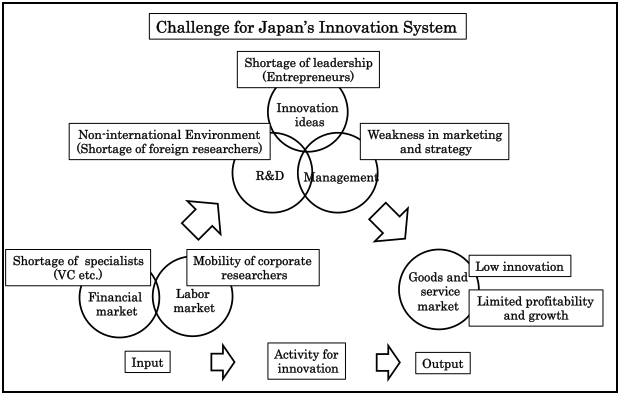The Japanese government sets the Basic Science and Technology Plan every five years. Recently, this plan has been serving as the basis for Japan's innovation policy. The next milestone is the spring of 2016 when the Fifth Basic Science Technology Plan will be laid down. Counting backwards, this means that 2015 will be the year for discussing the draft plan and 2014 the year for assessing the effects of the previous plans and identifying issues to be addressed in the forthcoming plan. Thus, as we start off 2014, I would like to present my personal view on the challenges for Japan's national innovation system.
Similar innovation policies around the world
Innovation arises in principle from free economic activities in the private sector and evaluation by the market, and neoclassical economics explains that the balance of market failure and government failure provides a ground for government intervention. Based on this theory, tax reduction for research and development (R&D) investments, government protection of intellectual property rights (IPR), and some extent of public funding on R&D are justifiable because: 1) the fruits of basic research are considerable as public goods in nature; 2) even patented technology has externalities because follower companies may emulate it in such a way not to infringe the patent; and 3) research involving high risk may not attract sufficient private-sector investments. On the other hand, neo-Schumpeterian economists, such as Richard Nelson, object to considering innovation and innovation policy under the framework of neoclassical economics because innovation gives rise to the dynamic evolution of the economy. They are proposing an alternative framework designed to analyze national innovation systems. According to their theory, systemic failure—not market failure—provides a ground for government intervention. Since innovation process is path-dependent and situation-specific and thus differs from one country to another, governments are expected to intervene in accordance with problems in their respective systems. The concept of national innovation systems has been accepted by policymakers in many countries, and the Organisation for Economic Cooperation and Development (OECD) conducted a series of studies in the 1990s through the 2000s, including comparative analyses of national innovation systems across member countries.
As it turned out, however, many countries pursued the same or similar innovation policy as they looked to U.S. innovation policy—the success of Silicon Valley in particular—as the benchmark. In other words, the promotion of industry-academia collaboration to facilitate the creation, transfer, and use of knowledge, the strengthening IPR protection, and the introduction of a law equivalent to the Bayh-Dole Act of the United States have virtually become a universal innovation policy for countries around the world including Japan. While these policy measures have yielded productive results, many policymakers and researchers have come to realize that it is impossible to repeat the success of Silicon Valley in all countries and regions, and the need for country-specific policies is now being discussed. This seems to be a natural consequence of the concept of national innovation systems. There is no doubt that promoting industry-academia collaboration and ensuring IPR protection will remain important. But it is about time for Japan to consider innovation policy measures focused on problems unique to its innovation system in addition to those measures mentioned above.
What are the challenges unique to Japan?
Then, what unique problems exist in Japan's national innovation system? A large portion of R&D in Japan is funded and carried out by the industrial sector, and excellent human resources for innovation are concentrated particularly in giant corporations. However, as they proceed with the so-called "select-and-focus" strategy to realign their business, those corporations are increasingly becoming hesitant to explore new, small markets. As the markets that require cutting-edge technologies tend to be small in size in their initial stage and often remain unnoticed by the top managers of giant corporations, this situation causes a mismatch between R&D strategy and business strategy. Such markets are suitable for smaller enterprises, and, for that matter, we should expect leadership from the top managers of small and mid-sized enterprises (SMEs) or the entrepreneurship of start-up businesses. However, they face constraints in both financial and human resources. Regarding financial resources, they suffer from a financial market problem, where financial institutions have a limited number of specialists to find new business opportunities, and only a limited amount of funds are made available to new businesses. Regarding human resources, there is a labor market problem. The mobility of senior researchers and engineers in the private sector remains low, even though there has been a significant increase in the mobility of university researchers. I personally believe those problems in the financial and labor markets have caused the low innovation in the goods and services markets as illustrated in the below figure.
This proposition is still immature and is no more than a hypothesis. Additionally, I don't have specific policy proposals to address these problems. However, I believe that the issues discussed above need to be given serious consideration in the medium- to long-term horizon.



